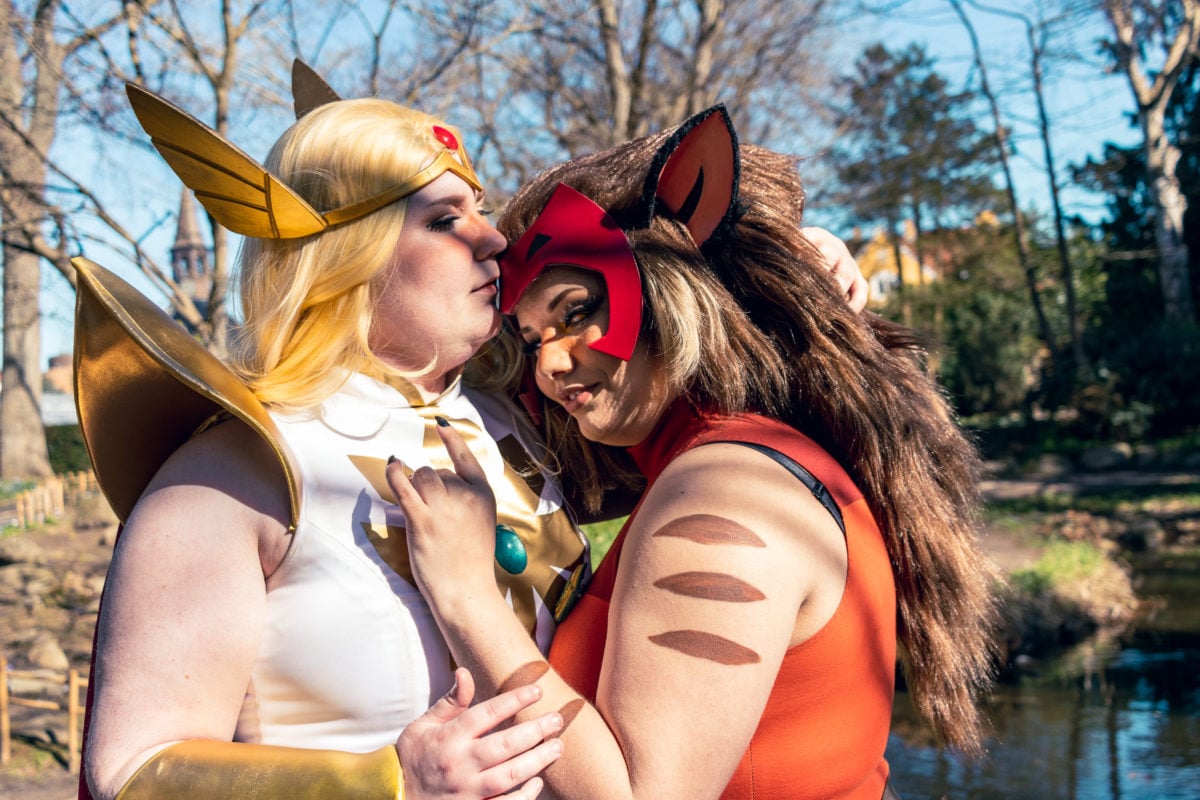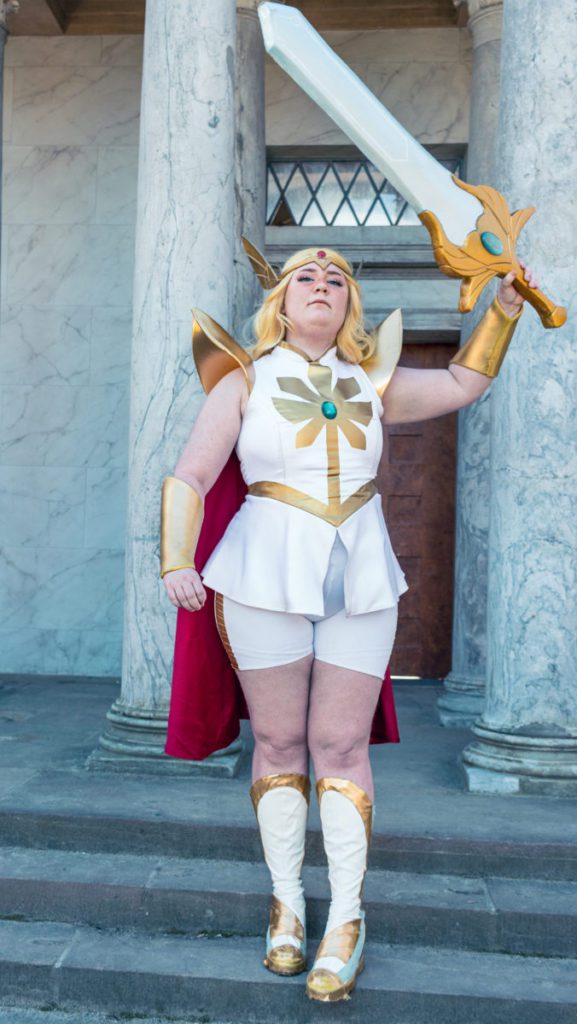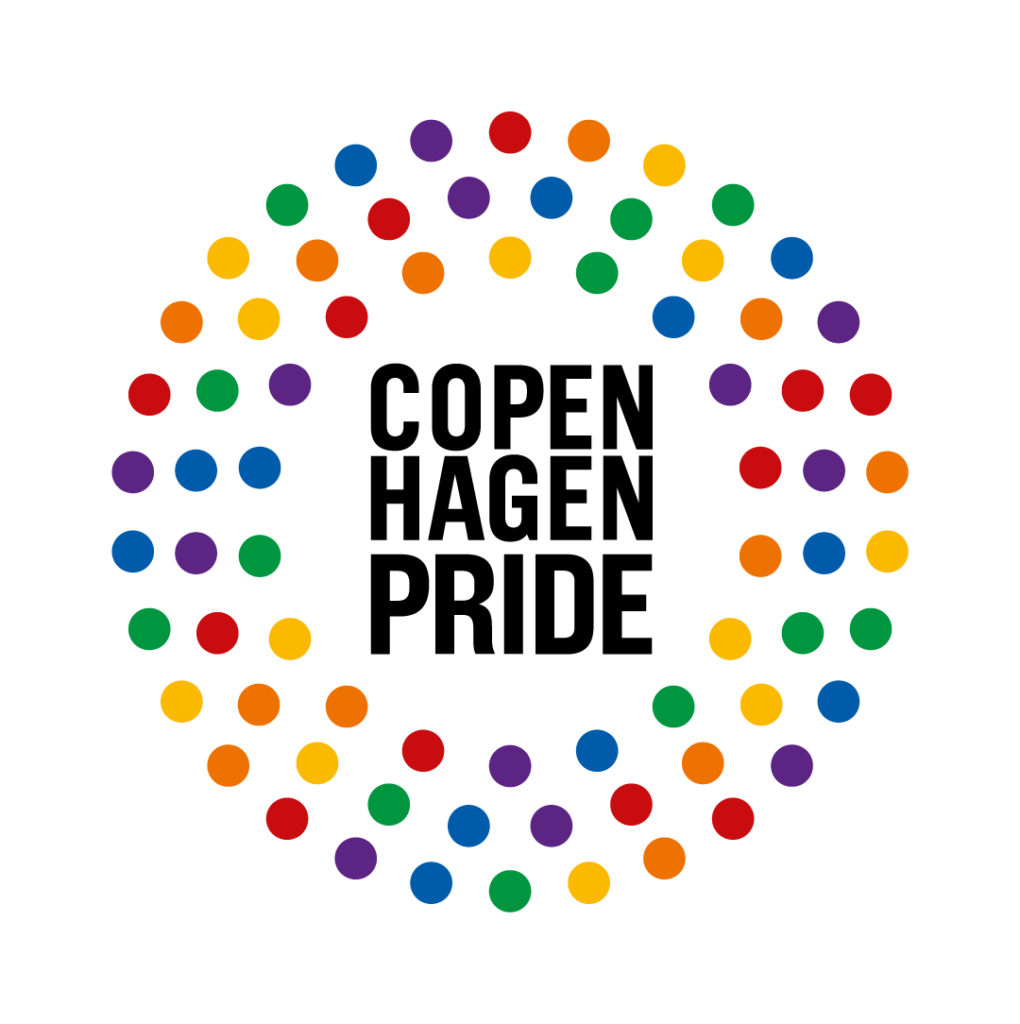
Seen for who I am
Photos: Rikke Høyen
Queerness & Cosplay
By Mariya Alfa Staugaard
Please note: This article contains mild spoilers for She-Ra and the Princesses of Power season 5.
Can you learn to understand yourself better while you are in character as someone else? It may sound contradictory, but in the world of cosplay, it isn’t far from the truth.
The term cosplay comes from a conjunction of the two words ‘costume’ and ‘play’ and describes an activity where you dress up as a fictional character, often from Japanese manga and anime, but also other tv series, games, or movies.
Hanne (they/them or she/her) and Stine (she/her) are engaged – and cosplayers. Stine has done cosplay for 12 years and now teaches an after school class on cosplay at Rødovre Ungdomsskole. Hanne has been doing cosplay for 11 years and they first met at a cosplay meet-up in Copenhagen where it was immediately clear that they were right for each other.
“It sounds cheesy, but it was love at first sight,” Stine says about the meeting with a smile.
A space for the weird and the queer
For a long time, the Danish cosplay community was considered to be underground and associated with niche interests. But for young people who struggle to fit in, it was a way into a community full of colorful fictional universes, shared interests, and an experience of being accepted for who you are.
To Hanne, cosplay provided a space where it was easy to communicate and make new friends: “To me, it’s been important to have something to talk about with people without feeling awkward. I have Asperger’s/autism, so I’ve always had some trouble with socializing. So it’s knowing that you have something you can talk about, and then you can talk about it for hours.”
To Stine, finding a community was a life altering experience.
“I found cosplay on the internet at a dark time – probably the darkest time in my life,” she says. “I had a really hard time communicating with others, so even when my classmates would seek me out, I didn’t know how to respond because I’d been isolated for so long. The concept of socializing was absurd to me – I was just the weird queer girl in the class.”
That all changed after Stine went to her first cosplay meet-up at Copenhagen Central Station. She was 12 years old and accompanied by her father, but after just half an hour she had made a handful of friends. “I don’t remember one bad second from that experience – I made contacts for life.”
Generally, the cosplay community has created a space for neurodivergence and people who are perceived as different, Hanne and Stine both say. But many LGBTI+ people also flock to the colorful hobby.
“The cosplay community is a space where there’s an openness to being different and where queer people get together,” Hanne says. “Most of our friends are pan or bisexual, otherwise they’re allies.” Stine continues: “They [the allies] also fight for us. Not just by saying ‘we support you, we see you’, but by showing up when we need help. They fight with us, not just with words.”
Hanne elaborates: “Since cosplay is becoming more accepted in society, it’s become more of a safe space for exploring yourself and figuring out: who am I? Now I have all these opportunities to explore gender and identity in the characters I choose and that I identify with.”
The Sakura Syndrome
In theory, you can cosplay as any character you’d like. However, Stine has experienced a form of unspoken rule set in the cosplay community, which has been constraining. “It’s interesting, because when we started out, it was dominated by women who cosplayed as men.” She continues: “It was actually a bit sexist. One thing is mostly cosplaying men, but when I first started, there was almost no room to cosplay women.”
It could be partially related to how the fandom understands the sexuality of the characters. As Hanne explains it: “I think it goes back to this fetishization of men who are attracted to men. In fandom spaces, shipping takes up a lot of space, and it should preferably be two men getting together. If you put a man and a woman together, the response is that it isn’t allowed because it’s not how the fandom wants to see these characters.”
Part of the issue is also the way that female characters in anime have been perceived by the fandom, Hanne says. “In these spaces there’s been a lot about how the women in these series were just obstacles for the male characters.”
Stine continues: “A good example is Sakura from Naruto. Sakura was definitely my favorite character and it was through her that I learned about cosplay. I just loved her and I remember that when I joined the community, she was just considered a character who stood in the way of Sasuke and Naruto [the two main male characters] getting together. We’ve actually dubbed it the Sakura Syndrome when a woman is considered an obstacle for a gay ship.”
Canon and representation
But all of that is in many ways changing. And it’s partially due to so-called canonically queer characters in the series that cosplayers are selecting characters from. For a character to be canonically queer means that their LGBTI+ identity is explicitly acknowledged in the series, either by stating it directly or by letting a romance play out. Historically, it has often been the case that the queerness of characters would be implied or left open for interpretation, but seeing openly LGBTI+ characters on the screen has been incredibly meaningful to Hanne and Stine.
Stine says: “There’s a show called She-Ra, and it almost brings me to tears to talk about it.” The two female main characters, Catra and Adora, spend five seasons building up chemistry until it finally happens: They kiss. “When I first saw the show, it made me sad because I thought they were going to keep the relationship platonic – but then they’re suddenly kissing.”
Glossary
Cosplay: An activity or hobby where you dress up as fictional characters.
Anime: Japanese animation TV.
Manga: In the Western world, manga is only used to refer to Japanese cartoons. In Japan, the word means cartoons in general.Fandom: A community who are fans of the same film, series, game, ect.
Ship/shipping: Comes from the word ‘relationship’. When a fan or fandom wants characters to develop a romantic relationship. A known example of a ship is Sherlock Holmes and John Watson, also known as ‘JohnLock’.
Canon: When a fact such as a relationship or an identity marker is made explicit in a series.
Hanne had barely dared to hope that Catra and Adora would get together, but then it happened: “And I screamed! It was such a magical feeling of being seen – for who I am, my identity and my sexuality.”
Hanne and Stine have cosplayed as Catra and Adora multiple times and have always been met with overwhelmingly positive reactions.
“My cosplay is an artform where I use myself as the canvas,” Stine says. “I consider myself to be a piece of fan art when I cosplay and I want to show my love for the fictional universe that I care so much about. And being able to show my love to someone who also shows it to me by making these relationships canon makes it so much more meaningful.”
Hanne elaborates: “It feels so much more real when you tell stories that reflect what real life is like. Because reality is not just straight people, with queer relationships being something you have to interpret into existence.”
The future of cosplay
Stine and Hanne agree that the cosplay community has developed in many ways in the decade they’ve been part of it – and mostly for the better. As Stine explains it, part of it has to do with the fact that many of the cosplayers have grown up: “And we can recognize what we were missing.” She continues: “There’s this tendency for drag queens to have their drag daughters. And for many years we’ve joked that we do the same thing in cosplay. But I feel it especially since I started teaching.”
Hanne emphasizes how meaningful it can feel to be a safe adult for young people to go to: “I had an experience at the Sakura Festival where one of Stine’s cosplay students stood and looked uncomfortable. I went over and asked if he was okay and he replied that no, he wasn’t. So I made sure that we stepped away and went somewhere quiet.” It’s that kind of caring that makes cosplay a safe space for a lot of young people who may not always feel like they belong.
Want to learn more?
There are a lot of places where you can seek out cosplay if you’re interested in the artform and the community. If you’re in the age group 14-15, it’s worth looking into whether after-school classes on cosplay are available in your municipality. Otherwise there’s plenty of information to be found online – Hanne mentions TikTok as a place with a thriving cosplay community, and Stine points to Discord as a place that a lot of cosplayers go to chat.
To Stine, there’s a lot of value to the fact that cosplay is spreading into mainstream media. “I think it’s really healthy. Because we’re a group of people who may be a bit neurodivergent or just outcasts, and we’re a community where there’s room for that.
PrideCon 2023
During Copenhagen Pride Week 2023 we’ll celebrate all things nerdy and queer with our new concept PrideCon! Come join us on 16.-17. at Huset-KBH and read more in the next edition of HeartCore.




